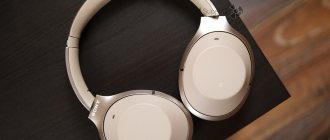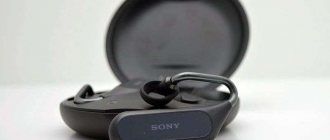Yesterday I took the WF-1000M3 out of my ears after continuous 4 hours of music, put the headphones in the case, threw it in my bag and thought hard. Very strong.
3 years ago such headphones seemed purely technically impossible. Almost all the dreams and fantasies of a music lover fit into one model, and the result was magic.
Six hours of battery life and 3 more full charges from the case, for a total of 24 hours of freedom from wires . Active noise reduction in headphones. Very comfortable fit, nothing falls out even while running.
This is all great, but it doesn’t yet lend itself to such an uncompromising title. Then what is it?
It's just that Sonу WF-1000XM3 has one more unattainable advantage - it's amazing sound . There is no other way to say it. Over the course of three years, I’ve listened to two dozen completely wireless models, from budget to the most expensive, and therefore I confidently say: you won’t find anything better than these Sonys in 2020.
I am ready to sign these words and answer for them. However, I'm not the only one. Let's go: what do the WF-1000XM3 offer and why do they have no competitor at all today?
There was an ugly duckling, but he became a swan. Brief history of the WF-1000XM3
Sony WF-1000X
Two years ago, Sony showed its first TWS headphones – Sony WF-1000X. In the midst of the manufacturer race, the Japanese entered the market with a truly unique offer: these were the only ears in the category with active noise cancellation.
As often happens, the first pancake came out lumpy in the most unpleasant places. The noise cancellation worked tolerably, but the headphones themselves were not very comfortable. The operating time turned out to be absolutely terrible; in reality it was a measly two hours.
The headphones did not fit well with the charging pads of the case. The connection between the left and right “ear” was often severed for no apparent reason. And the sound quality was mediocre, no worse or better than all other competitors.
Sony WH-1000XM2
Together with them, Sony released the WH-1000XM2 full-size “noise cancellers,” which are globally opposite in quality, and immediately shook Bose’s leadership in this category. And there was also the incredible sound quality wireless headband WI-1000X, which I wore until recently almost without taking it off.
Compared to these models, the WF-1000X seemed like an out-of-place ugly duckling with which everything went wrong.
All the more surprising is how high quality the new WF-1000XM3 turned out to be. There is almost nothing in common between them and the “progenitor”, except for the concept. Sony not only worked on the mistakes, but passed the exam with flying colors, stood up at the podium and said: now I will teach you how to do it.
Noise suppression
I saved the main bun for dessert. Now I’ll tell you everything.
Turning on the headphones, activating a particular function - all this is accompanied by voice prompts. The voice is female, the language is, however, English. Why they didn’t translate it into Russian, I can’t say. Many people may not know English words. Yes, and this would be a kind of nod to Russian-speaking users who paid $500 for headphones, for a moment.
Now about the noise reduction itself. Frankly, these are my first headphones with this feature, so my opinion is by no means authoritative in this regard. I will only tell you what I actually heard.
In theory, I imagined that the “noise reduction” works as follows. In front of you there is a certain source of quite loud sounds. I put on my headphones and the sound was muffled. I turned on the noise reduction and you can’t hear anything at all. So in 1000X everything is different.
Firstly, the dense cushions of the ear pads themselves do a good job of muffling the surrounding sounds. Nevertheless, a fairly noticeable part of the noise still remains.
Secondly, when the “noise reduction” is activated, all remaining noise becomes two to three times quieter, but does not completely disappear. Moreover, they are slightly modified. It’s as if all the surrounding sounds were recorded on a tape recorder and played on your headphones, only quietly and from somewhere behind, from afar.
The headphones are excellent at blocking out traffic noise. The hum of the subway or airplane is perfectly “eaten up” by the function and in the end you only hear an incomprehensible, weak hiss from somewhere behind and below. In other words, low and mid frequencies are “choked” quite well. The accessory does not cope so well with high-frequency sounds.
In any case, the function works and here's a simple proof. I didn't notice how I arrived at Kyiv Station by train on my last trip. I just saw that people began to get up and leave the carriage.
Design, case and fit
As usual, Sony's design is fine. The WF-1000XM3 look moderately strict, stylish and do not at all look like a hearing aid (ahem, Xperia Ear Duo).
They are inserted into the ear in a tricky way: we start vertically, then turn horizontally to a comfortable level. The stronger, the stronger they are fixed. For some, the headphones will end up being kept strictly parallel to the floor, while for others (like me) they will remain slightly at an angle downwards.
No matter how you place them, they hold up just fine. At least jump on one leg. No “behind the ears” is required.
I wore this model for 3 weeks, 3-6 hours at a time, and never felt any discomfort. For ergonomics, pure five points, without any “buts”.
The WF-1000XM3's “boxes,” of course, are not small. It will fit in your pocket, but not particularly comfortable. However, it will fit perfectly in a bag or backpack.
The headphones easily fly inside and are fixed with powerful magnets. The LEDs on each glow red while charging is in progress. There is another indicator between the lid and the case so as not to open it too much.
The case charges via USB-C, and thank God.
Design and management
I definitely liked the calm, discreet design of the headphones.
There are no bright, flashy inserts like “Look! And I have fashionable and expensive headphones!” In addition, there is not a hint of bad taste, which various Chinese manufacturers are guilty of, trying to make their products as premium as possible.
But I didn't really like the color. They sent me light gray “ears” for testing and they look kind of strange. Too neutral color for my taste.
There is also another, black model on sale. And that's it. A classic that you can't beat.
Metal is present here only in the bow. Most of the body is made of plastic. The cups are covered with artificial leather (eco leather), very soft to the touch.
Each earphone has a small perforation for microphones that “listen” to external sounds and filter the whole thing into your ears. I'll tell you more about this a little later.
All control buttons are located on the left channel. Each key is marked with a protruding plate, so they are easily distinguishable by touch. You get used to their location very quickly.
Right there on the left side you can see the NFC protocol icon, with which you can pair the accessory with your smartphone in one touch. True, the connection via Bluetooth is fast and smooth. Everything is as usual here - just hold down (6-7 seconds) the power button and the pairing mode will be activated.
The micro USB charging port is located on the right channel. It is not covered with anything and looks somehow dubious. The engineers could have made a plug for the charging connector that was symmetrical to the control keys, but for some reason they didn’t bother. There is an LED charging indicator next to the port.
The outer part of the right cup is touch sensitive, although this is not indicated at all on the surface itself. Double tap is supported, which is responsible for the play/pause function and various gestures. Swipe up to increase the volume, swipe down to decrease the volume. Swiping left or right switches tracks.
The most important thing is that gestures are always recognized correctly and sensitively. There is no need to place your finger directly on the center of the cup and carefully insert your finger to the side parallel to the floor. I swiped from left to right and it worked.
Getting used to this type of control again takes minimal time.
Iron and technology
In terms of technology, the Sony WF-1000XM3 can easily be called microcomputers, because each headphone fits a train and a cart of top technologies:
▪ emitting/receiving system ▪ data transmission system ▪ noise reduction system ▪ service sensor system ▪ power system.
I'll start with the wireless connection. Regular fully wireless Bluetooth headphones use only one signal receiver from the device. That is, first the sound comes from the smartphone to, conditionally, the right earphone. And from it the signal corresponding to the channel goes to the left (again conditionally, maybe the other way around).
The WF-1000XM3 use independent data transmission : each earphone receives a signal directly from the source. This reduces sound delay (lag) and increases connection reliability.
In addition, channel desynchronization is now impossible and maximum playback accuracy is achieved - the processor in the headphones does not cut off part of the sound in order to “keep up” with the second headphone.
The WF-1000XM3 independently improves the sound of an audio track in every way available today, including built-in DSP processing.
The Bluetooth signal first goes through digital noise reduction and processing in 24-bit quality, and only then it reaches a digital-to-analog converter (DAC) and is amplified to an audible level.
All processing from audio reception to audio output is handled by Sony's unique proprietary QN1e In fact, this is a smaller version of the chip from the full-size WH-1000XM3 that took the world by storm.
The QN1e also works with acoustic waves collected from four Sony WF-1000XM3 microphones arranged in pairs.
A system of internal and external microphones on each earphone allows in real time not only to monitor the noise from outside, but also to analyze the difference in it at the ear pad and on the outside.
What does this give? The processor in each earphone processes noise independently of the other, taking into account the influence of the ambushes. Thus, a person actually hears differently processed sound in each ear.
Sampling the signal to 24 bits instead of the usual 16 allows you to improve the quality of even MP3 and streaming music, since the smallest parts of the wave are subject to DSP processing.
The same thing happens with noise reduction: by splitting the acoustic wave into many parts, the processor applies transformations much more accurately, without losing detail in the music.
Instant response is not the only advantage of the proprietary noise canceler Sony WF-1000XM3. Engineers have implemented a smart system that allows you to remove the headphones only for charging.
Need to hear ambient noise outside? Can they ask you something at the office? Do you want to hide in music or a podcast while on public transport? Each of these scenarios is implemented in the Sony WF-1000XM3 and is available through the proprietary Headphones Connect (App Store, Google Play).
Scripts can be activated automatically based on your activity. Or manually:
▪ Waiting allows you to listen to music so that human speech can be heard
▪ Walking transmits the entire spectrum of loud and harsh sounds around into the headphones
▪ Music Only changes the sound of music or other audio material so that it completely drowns out external noise.
Noise reduction uses complex psychoacoustic models that implement the effects of masking sound with another sound that is opposite in frequency or amplitude to the external one. In this case, only the necessary element of the acoustic wave changes, so it practically does not affect the music .
In each scenario, noise cancellation can be adjusted not only automatically, adaptively, but also manually: a slider in Headphones Connect allows you to set the type of external noise or adjust the intensity of noise cancellation in general.
The WF-1000XM3's playback controls are controlled by touch panels , which is frustrating. I've always been in favor of physical buttons or gestures like "tapping" the earpiece. Of course, I got used to it quickly, but buttons rule.
Touch pads recognize the number and duration of presses. There is a Quick Attention function that, when touched, lowers the music volume and allows you to hear the world around you without removing your headphones.
A single press on the left earphone turns on noise reduction, similar to the right one – Play/Pause. Double-clicking the right one plays the next track, triple-clicking the previous one, holding turns on the voice assistant, including Siri .
When you activate Google Assistant, you can even control it: work priority allows you to stop the assistant with a single click, a double click to receive a notification, and a long one is used to ask a question.
Any earphone can be used as a headset. But you should be careful: if you remove one earphone, the music will stop, but the call will not be interrupted.
Active Noise Canceling and App
Sony WH-1000XM4 – wireless headphones with excellent active noise reduction . It's still the best, or one of the best (along with the Bose version) on the market. The physical filling (chip) remains the same, only the algorithm settings have changed. The most obvious change is the improvement in noise reduction adaptability.
By the way, passive sound insulation here is at a good level. In relatively quiet conditions, you may not need to turn on the electronics at all.
Now ANC (Active Noise Cancelling) better adapts to the surrounding environment . At the same time, the more often you visit the same places, the better the automation works. That is, somewhere the noise reduction is turned on to maximum, somewhere in a more gentle mode (if the environment is not so noisy), and somewhere it can turn on the “transparency mode” when you need to hear the sounds around you.
Sony WH-1000XM4 Bluetooth headphones with ANC
Sony WH-1000XM4 box
This works by “remembering” the coordinates of specific locations . You can customize everything in the application yourself: specify places and noise reduction modes separately for each. The function is interesting. Sony “swear” that GPS coordinates are not sent to their (or other) servers, and are not transmitted anywhere from the headphones at all. But who knows…











